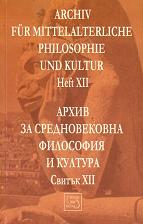Marsilio Ficino’s Celestial and Earthly Aphrodite in the Art of Sandro Botticelli
Marsilio Ficino’s Celestial and Earthly Aphrodite in the Art of Sandro Botticelli
Author(s): Bistra NikolovaSubject(s): Philosophy
Published by: Издателство »Изток-Запад«
Keywords: Marsilio Ficino; Celestial Aphridite; Earthly Aphrodite; Sandro Botticelli; Renaissance; Academia Platonica; Eros
Summary/Abstract: Towards the end of the 15th century studia humanitatis and the humanist spirit of Renaissance Florence has intensifiedbythephilosophical, intellectual, metaphysical and spiritual quests of the Platonic Academy in Florence. Marsilio Ficino fuses prisca sapientia and Christian dogma to create a universal philosophy: a Christian platonism, which determines the intellectual and cultural perspective of the Renaissance and sets the context for the spiritual, cultural, scientificquests of the Age. The philosophical system of Ficino develops the humanistic worldview – intensifying it and widely broadening the dimensions of the humanist perception of Man’s standing in God’s Creation. Ficino’s system brings God back into the universe in an intimate connection with His creation. The teaching of the divine principle in the Soul – its immortal center through which it could reach God through its own self – makes it possible for man to seek communion with God and to celebrate Divinity on earth. The Neoplatonism of Ficino and the Platonic Academy in Florence reveals for Renaissance art the interconnection of inner and outer, the understanding of physical beauty as reflectionofspiritualgrace,theperceptionofnaturalbeautyas reflectionofdivinemagnificence.ForFicinothefunctionofartisto remind the soul of its divine origin and to help it be united once again with its divine source. The enormous impact Marsilio Ficino’s ideas have on all spheres of life in Florence sets the foundation for the change in the perception of art and sets the context for the creation of the Renaissance masterpieces. His influenceistracedandacknowledgedinthe works of great artists as Sandro Botticelli, Michelangelo Buonarotti, Leonardo da Vinci, Raphael, Titian and Albrecht Durer.
Journal: Архив за средновековна философия и култура
- Issue Year: 2006
- Issue No: 12
- Page Range: 219-234
- Page Count: 16
- Language: English
- Content File-PDF

